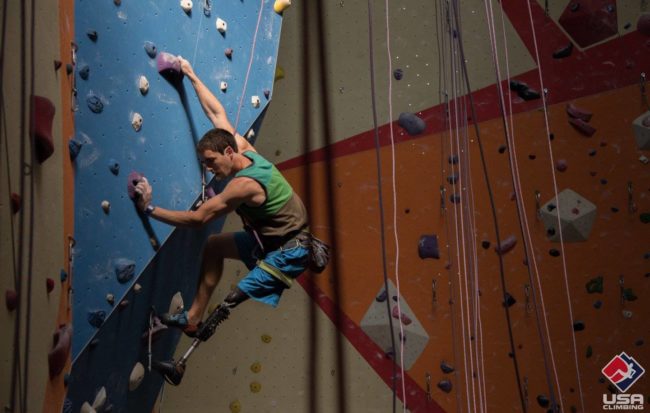
By Amanda Ashley
Youth competitive climbing has exploded in the US, and nowhere is that growth more apparent than in the growth of USA Climbing memberships. Since the beginning of the 2007-2008 season, there has been a 150%, overall increase in youth memberships, with a notable increase of 165% in the female categories.
“Over the last 5 years, USA Climbing has experienced significant growth in almost every relevant metric. Although I would normally hesitate to make any specific predictions or projections about the future of USA Climbing, I don’t see our growth rates slowing down any time soon,” said Kynan Waggoner, CEO of USA Climbing.
With continued growth expected in the future, competitive youth climbing teams are becoming standard practice at indoor climbing gyms, and have become important tools for building a companies brand and increasing revenue.
‘Youth competitive climbing is on an exponential curve of growth and change. I’ve been involved since the beginning, and the leadership of USA Climbing has taken us to a whole new level, year after year. We are going to the Olympics in the not too distant, future and when it’s there, it’s not going to look anything like it looks today.’ Coach Kyle Team Texas
So what does the modern climbing team look like? CBJ sits down with Momentum, Earth Treks, Mesa Rim Climbing Center and Team Texas to learn the benefits, logistics, costs and ROI of having a competitive team.
Does it Fit Your Business Model
To have a successful team, one of the most basic questions that needs to be answered is: What is your vision for your brand?
When Momentum started their youth competition team in 2008, they knew the program was in line with their mission and their branding image, says Momentum CEO Jeff Pedersen. “As a gym operator, if having a comp youth team is important, do your research and tour facilities that have comp programs. Learn the ins and outs of this part of the business because integrating the comp team with the daily use members is extremely challenging,” he said.
This sentiment and drive to create a well-rounded business around core values is also what drives team development at Mesa Rim. Co-owner, Bob Kain told CBJ, “We want to create new climbers at a young age, while helping aspiring competitive climbers achieve their goals.” This integrated approach to developing new business that is supported by your mission, builds strong climbing ambassadors in your community and can lead to changes in your business.

Youth Programs Come First
More often than not, teams are developed out of existing youth recreation and club teams. But it will quickly become apparent that there are youth climbers in your gym that want to take their climbing to a competitive level. However, it is important to note the difference between a recreation program and a competitive climbing program.
Head Coach Rosie Bates of Mesa Rims, sums it up: “The focus of intro programs is to introduce climbers to the sport. Most intro climbers need to be eased into climbing and the failing/falling dynamic that comes along with it. The focus of these programs is to make the climber feel success in any capacity. For the team that is almost the opposite. It is important to put emphasis on putting them in uncomfortable situations so they can learn how to improve,” she said.
Understanding this difference and building a successful youth program prior to developing a team is crucial to the success of both. Jeff Pedersen of Momentum leanred this lesson through experience when Momentum opened their Sandy, Utah location in the spring of 2007. “In the early days we weren’t focused on building the team, because simultaneously, we were starting to develop our youth recreational programs and spent our time developing the comp program the right way for us,” he recalls.
Coach Kyle Clinkscales of Team Texas, Shares his top three tips for building a successful team:
Have junior programs, rec programs, kids club, all in place before building a team. Find a passionate, skilled coach before you recruit team members. Make sure everyone in the gym is committed and on board….if the gym wants to have a comp team, everyone has to support the team and support USA climbing.
Building and Retaining the Support Team
Not only do team members pay a monthly fee, when they travel to compete, there will be additional expenses for families and many parents may have expectations about training, performance and communication. Determining who should be coaching and who shouldn’t, can be challenging.
Currently for coaches to become USA Climbing Certified, they must pass a background check, signed the Coaches Code of Conduct and be certified in basic first-aid and CPR. However, you’ll quickly realize that coaches need climbing specific experience, training know-how, and most importantly, they must be able to coach kids. Choosing the right coach is only half the battle, once you have the right staff in place you then need to develop the coach and work towards retaining staff.
Earth Treks chose a proactive approach by making a commitment to the coaches with full-time positions at the gym. By combining coaching with other responsibilities such as route setting, instructing at the Outdoor School, and first level management positions in the gym, Earth Treks improved retention and consequently professional development for coaches.
Coach Kyle links the professionalism of the coaching staff with team growth. “By developing qualified and passionate coaches I’ve seen participation in comp teams grow,” he said. As indoor competitive climbing continues to grow, coaching needs to be viewed as a career. The development of coaching as a career has lagged behind the incredible growth in indoor climbing overall,” he said.
“Our leap of faith was knowing if it’s been done, Momentum could also do it. The key was finding the right people, the right organizers in addition to coaches. Creating the infrastructure was a big step for us and hiring the right talent to administrate multiple programs made all the difference.” –Jeff Pedersen, CEO, Momentum
Exponential Growth
Reflective of the growth at USA Climbing, the youth programs at Momentum have doubled in size every year since 2013, which pipelines a large population of kids that have the potential to be on the comp team. Pedersen has found that team development pays off exponentially over time. “This year we have qualified our highest number of kids to travel to the USA Climbing Sport and Speed National Championships,” he said. “It has taken so much more work and was so much more difficult than I initially thought it would be. The steady revenue increase has allowed us to hire better coaches, club and team managers. All of this is starting to show now on the competitive team output.”
Momentum isn’t alone in their growth, Mesa Rim started the 2012 season with one coach and 3 athletes, started 2014 Bouldering season with 4 coaches and 28 athletes and ended 2016 sport/speed season with 9 coaches and 98 athletes. Meanwhile Earth Treks, with 4 gyms in Maryland and Colorado, has a team with 3 levels and 36 team members per level at each gym.
Making it Work
While smaller teams are easier to manage from a coaching perspective, one of the struggles initially is having an awkward size program where you are starting to grow, but you are too small to justify splitting youth athletes into categories based on age and ability, with coaches for each category. On average, gyms keep a 1:6 coach to team member ratio, which allows coaches adequate time to develop relationships with the athletes and to build individual skills. It is hard to balance the needs of the different abilities of climbers when you aren’t at a place to have separate programs.
“You don’t want athletes to feel frustrated by being in the wrong group. As soon as we were able to place kids into appropriately focused groups, that’s when the program exploded. Having kids with the right peer groups made it more fun for the kids too,’ says Jeff Pedersen. Coach Kyle agrees, “It’s easier with less kids, to build individual skills, the real problem is that when you are successful you will be overrun.”
What are the Business Impacts
When you add a comp team you’ll find additional expenses, and revenues as the team grows. How you handle each one will largely be defined by how well you plan and prepare. Initial expenses can be limited to labor with coaches and support staff, as your team grows and your gym becomes more involved in competitive climbing you may host comps which will lead to expenses with setting and closing the gym for events.
When team members go to comps, so do coaches, and you’ll need to cover travel expenses and wages. Teams can provide job opportunities and professional development for staff in the gym which can help reduce turnover and improve retention. When teams are successful, gyms discover they need to change their facilities to meet the needs of competitive climbers and trends in competition.
As teams continue to grow and gyms grow their brand around the team, the next step, according to Pedersen is designing spaces that can work being closed off to the rest of the gym at various times.
ROI
Relative to revenue from day members, a successful comp team doesn’t always have a heavy impact on the P&L, especially when you start with a handful of youth climbers. But, comp team fees that range from $200 to $350 per month add up, especially when you build a large team. Large teams are a material contributor to revenue as team members pay more each year than regular members, due to the increased personal coaching. In addition to the team fee, increases in membership revenue from families and retail sales have a material impact, both of which support and enhance core business strategies.
The ROI that doesn’t show up in the books, is one that can have an impact on building and expanding your brand. At Momentum, Pedersen recognizes these revenue offsets as grassroots word of mouth and media exposure, when their athletes perform on a national and world stage. And it is worth asking, what is that word of mouth and media worth for your brand?
For Pedersen it’s become part of a greater branding effort. “We’ve had a youth athlete take a podium at World Cup, and we can tie that story back to Momentum, about how they learned to climb here and worked their way up through the ranks,” he said. “It builds legitimacy for the youth program in general, even for kids and families who aren’t looking for a competitive program. As Momentum expands its brand, this PR can be incredibly valuable for us; it’s a way for us to establish a presence in new markets.”

Climbing Business Journal is an independent news outlet dedicated to covering the indoor climbing industry. Here you will find the latest coverage of climbing industry news, gym developments, industry best practices, risk management, climbing competitions, youth coaching and routesetting. Have an article idea? CBJ loves to hear from readers like you!







